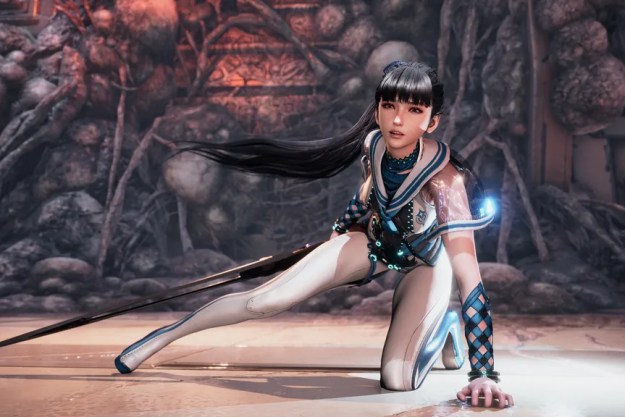Ghostwire: Tokyo, Bethesda’s last PlayStation-exclusive game, has been a mystery for years now. First shown at E3 2019, the game got a cryptic trailer filled with creepy visuals and no indication of how it would actually play. A gameplay trailer eventually confirmed it was a first-person action game with magic, but the specifics remained unclear.
During a recent digital press event, I saw around 30 minutes of uninterrupted gameplay footage, finally shedding some light on Bethesda’s puzzling game. For those who crave a straight explanation, it’s a first-person action game where players explore Tokyo. It has open-world hooks that aren’t too dissimilar from, say, Far Cry 6.
That’s all accurate, but it undersells just how positively strange it is. Ghostwire: Tokyo, set to launch on March 25 is shaping up to be a trippy supernatural journey filled with faceless monsters, finger guns, and magical bodega cats. You read all that right.
Pew pew
Ghostwire: Tokyo has an eerie premise: All of Tokyo’s residents have suddenly vanished, turning the city into a ghost town. And I mean that literally. The once-bustling streets are filled with creeping spirits, otherworldly corruption, and progress-blocking fog.
Players control Akito, who fuses with a legendary ghost hunter named KK and sets out to find the mask-wearing person responsible for the disappearances, Hannya. KK gives Akito powers called “spiritual weaving” that allow him to sense spirits, cast spells, and shoot magic out of his hands.
Yes, Akito pretty much has finger guns. During the demo, I saw Akito fighting faceless monsters that stalk around with decaying umbrellas. He keeps a safe distance from them before blasting them with glowing, yellow shots. When they’re weak enough, he yanks their “cores” out by attaching yellow cords to enemies and pulling them apart at once.

It’s one of the strangest combat systems I’ve seen in a first-person game and it had me squealing with deranged glee. Akito’s powers take basic mechanics that you’d find in a shooter and translates them to mystic arts. Instead of stealth killing a demon by stabbing it with a knife, he jabs his hand in its back to disintegrate it. At one point, he appears to block an incoming attack with a quick force field, giving him defensive powers. The only traditional weapon I saw was a light-shooting bow and that was a deliberate decision.
“The enemies in the game are non-physical beings or evil spirits,” the game’s director, Kenji Kimura, tells Digital Trends. “We thought about using physical weapons like guns and hammers initially, but it didn’t make much sense. In Japanese history, we have our version of wizards that helped Lords back in the day called Onmyōji. We took hints from that kind of universe.”
Magic isn’t just for battles. Through the demo, I saw Akito unlock a door by physically drawing runes on the screen, use spectral vision to follow a wandering spirit, and get up to a rooftop by grappling onto a legendary creature called a tengu.
The game includes a skill tree and Akito seems to unlock new skills by praying at shrines. I’m excited to see how much deeper the rabbit hole goes because the concept of a first-person game that trades guns for spells seems particularly fun.
Tokyo story
What’s most striking about Ghostwire: Tokyo is the way it fuses modern-day Tokyo, folklore, and the supernatural together. That idea comes from developer Tango Gameworks wanting to represent the unique fusion of old and new present in Tokyo itself, with many creative ideas born out of walks around the city.
“Tokyo is a nice combination of traditional and old,” Kimura says. “When you’re walking down the streets in Tokyo, you could see a building that’s super-modern and it’s right next to a traditional shrine. When looking at the older and newer things, we started to see that things were designed because of folklore or some kind of tradition. It’s a culmination of that train of thought.”

While it could be described as a standard “map game,” the usual video game tropes are offset by visual creativity. One of the game’s primary “collectibles” comes in the form of spirits. When Akito finds a spectral being floating in the street, he raises a paper katashiro (ceremonial object) up to absorb it. He then walks over to a phone booth and flips open the telephone inside to reveal a device that lets him deposit captured spirits.
That level of weirdness ran through the demo. At one point, Akito walks into a convenience store that doesn’t look so different from something out of the Yakuza series. The only difference is that the creature behind the counter is a floating cat that sells him dog treats and dango (a type of dumpling). Yokai (supernatural spirits) are a big part of the game, with a trailer teasing that more helpful creatures will show up along the way.

Though some of the spirits look terrifying, producer Masato Kimura insists that it’s not a horror game.
“Sometimes we explain things in nature using yokai,” Kimura tells Digital Trends. “If it’s a windy day, we would say there’s a specific type of yokai that is flying around. Sometimes those stories get passed on to teach children specific rules. [Parents] don’t want their children walking around at night, so they might tell a scary story and bring yokai into it. They might look a little horrific sometimes because of that, but there was never an intention to make a horror game.”
Something new
The demo got especially trippy when it tackled a primary story set piece. Akito enters an apartment building to retrieve a bow. When he walks out, the entire building has been encased in a multicolored barrier that’s slowly crushing the building. A timer starts and Akito begins running around the apartment complex destroying orbs. Things get weird when he runs into a hallway that suddenly flips sideways as it’s engulfed in psychedelic colors.
Later in the sequence, he runs through a series of rooms that have been flipped in different ways. He’s on the ceiling of a bathroom one minute, and then platforming up the wall of the living room the next. As he approaches the final orb, the building falls away entirely and he’s dashing over a catwalk seemingly suspended in air.

That seems like the tip of the iceberg. While the gameplay demo largely focused on combat and city exploration, other accompanying clips teased some truly out-there sequences. I caught what looked like a staircase of umbrellas forming in midair at one point and a demon woman with racoon paws.
For Tango Gameworks, that level of originality is critical to its mission. The studio is committed to taking bold, creative risks. For Tango studio director and video game legend Shinji Mikami, those original ideas tend to come from young creators. Mikami, who’s best known for directing Capcom games like the original Resident Evil, has taken on something of a mentor role at the studio.
“I like seeing young talent who are outstanding at what they do,” Mikami tells Digital Trends. “I want to be able to help young talent create their own success stories. The younger talent is more geared to make new things in comparison to an older group trying to make something new.
Every minute of the gameplay I saw had me surprised in a way that most big budget games rarely accomplish. If Ghostwire: Tokyo can keep that momentum up for an entire game, it could be one last PlayStation killer exclusive before Bethesda becomes a full-time Xbox publisher.
Ghostwire: Tokyo will launch on March 25 on PS5 and PC.
Editors' Recommendations
- I was a PlayStation Portal hater. Now it’s one of my go-to gaming devices
- 3 realistic improvements we want to see with PS5 Pro games
- You need to try PlayStation VR2’s most psychedelic game yet
- You need to check out this killer action game on PS Plus this month
- Every rumored Xbox exclusive coming to PS5 and Switch




